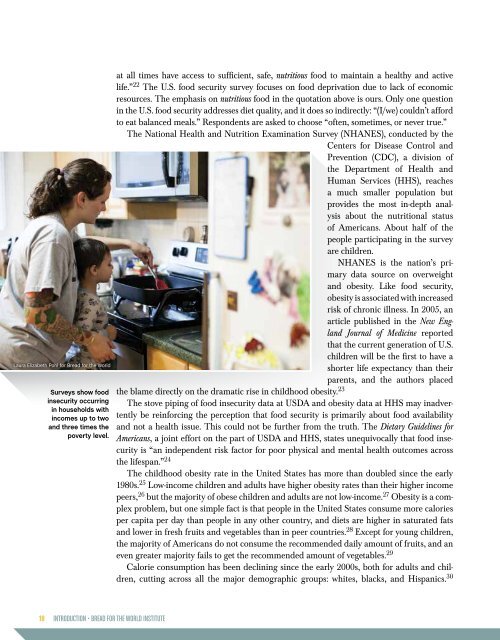THE NOURISHING EFFECT
HR2016-Full-Report-Web
HR2016-Full-Report-Web
You also want an ePaper? Increase the reach of your titles
YUMPU automatically turns print PDFs into web optimized ePapers that Google loves.
Laura Elizabeth Pohl for Bread for the World<br />
Surveys show food<br />
insecurity occurring<br />
in households with<br />
incomes up to two<br />
and three times the<br />
poverty level.<br />
at all times have access to sufficient, safe, nutritious food to maintain a healthy and active<br />
life.” 22 The U.S. food security survey focuses on food deprivation due to lack of economic<br />
resources. The emphasis on nutritious food in the quotation above is ours. Only one question<br />
in the U.S. food security addresses diet quality, and it does so indirectly: “(I/we) couldn’t afford<br />
to eat balanced meals.” Respondents are asked to choose “often, sometimes, or never true.”<br />
The National Health and Nutrition Examination Survey (NHANES), conducted by the<br />
Centers for Disease Control and<br />
Prevention (CDC), a division of<br />
the Department of Health and<br />
Human Services (HHS), reaches<br />
a much smaller population but<br />
provides the most in-depth analysis<br />
about the nutritional status<br />
of Americans. About half of the<br />
people participating in the survey<br />
are children.<br />
NHANES is the nation’s primary<br />
data source on overweight<br />
and obesity. Like food security,<br />
obesity is associated with increased<br />
risk of chronic illness. In 2005, an<br />
article published in the New England<br />
Journal of Medicine reported<br />
that the current generation of U.S.<br />
children will be the first to have a<br />
shorter life expectancy than their<br />
parents, and the authors placed<br />
the blame directly on the dramatic rise in childhood obesity. 23<br />
The stove piping of food insecurity data at USDA and obesity data at HHS may inadvertently<br />
be reinforcing the perception that food security is primarily about food availability<br />
and not a health issue. This could not be further from the truth. The Dietary Guidelines for<br />
Americans, a joint effort on the part of USDA and HHS, states unequivocally that food insecurity<br />
is “an independent risk factor for poor physical and mental health outcomes across<br />
the lifespan.” 24<br />
The childhood obesity rate in the United States has more than doubled since the early<br />
1980s. 25 Low-income children and adults have higher obesity rates than their higher income<br />
peers, 26 but the majority of obese children and adults are not low-income. 27 Obesity is a complex<br />
problem, but one simple fact is that people in the United States consume more calories<br />
per capita per day than people in any other country, and diets are higher in saturated fats<br />
and lower in fresh fruits and vegetables than in peer countries. 28 Except for young children,<br />
the majority of Americans do not consume the recommended daily amount of fruits, and an<br />
even greater majority fails to get the recommended amount of vegetables. 29<br />
Calorie consumption has been declining since the early 2000s, both for adults and children,<br />
cutting across all the major demographic groups: whites, blacks, and Hispanics. 30<br />
18 INTRODUCTION • BREAD FOR <strong>THE</strong> WORLD INSTITUTE


